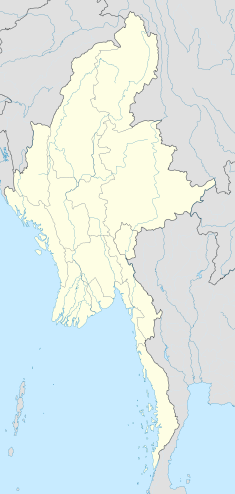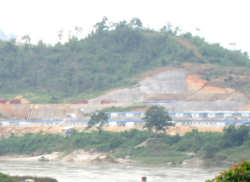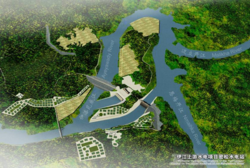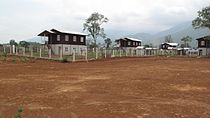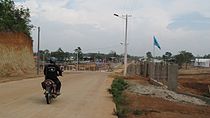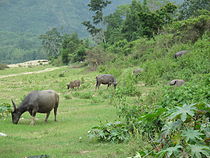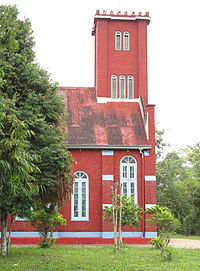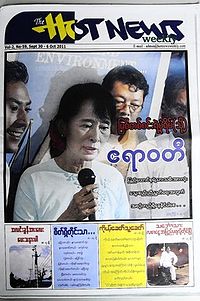- Myitsone Dam
-
Myitsone Dam 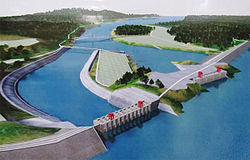
Rendition of Myitsone DamLocation of Myitsone Dam Official name မြစ်ဆုံ တာတမံ Location Kachin, Burma Coordinates 25°41′23″N 97°31′4″E / 25.68972°N 97.51778°ECoordinates: 25°41′23″N 97°31′4″E / 25.68972°N 97.51778°E Construction began 2007 Opening date 2017 est. Construction cost US$ 3.6 billion Owner(s) Myanmar Electric Power Enterprise, China Power Investment Corporation, China Southern Power Grid Dam and spillways Type of dam Concrete faced rock-fill dam Height 152 m (498.7 ft) Length 152 m (498.7 ft) Impounds Irawaddy River Reservoir Creates Myitsone reservoir Surface area 766 km2 (295.8 sq mi) Max. water depth 290 m (951.4 ft) Power station Installed capacity 3,600 MW Annual generation 16,634 Gigawatt hours per year[1] The Myitsone Dam (Burmese: မြစ်ဆုံ တာတမံ, IPA: [mjɪʔsʰòuɴ tàtəmàɴ]; lit. the Confluence Dam) is a large dam and hydroelectric power development project currently under construction on the Irawaddy River in Burma (Myanmar). If completed as planned in 2017, it will be the fifteenth largest hydroelectric power station in the world. The dam, planned to be 500 feet wide and 500 feet high, is being built by Burmese government contractors and the China Power Investment Corporation (CPI). It is estimated that it will provide between 3,600 to 6,000 megawatts of electricity primarily for Yunnan, China.[2]
The dam project has been controversial in Burma due to its enormous flooding area, environmental impact and its location on the Saging fault line. The electricity generated will be distributed mainly to China for fifty years despite limited power supply in Burma. The Burmese public also resent the growing Chinese influence in Burma, whose companies have invested billions of dollar in the country, mainly in the energy sector. Even the government itself appears divided on the project.[2]
On 30 September 2011, President Thein Sein announced that the Myitsone dam project was to be suspended during his tenure.[3] The unexpected decision has been widely applauded by environmentalists, activists and the public for the government appears to have taken the public opinion into account for the first time in many years.[3]
In response to the President Thein Sein's announcement, Chinese Foreign Ministry spokesman Hong Lei called on Myanmar to hold consultations to handle any problems with the Myitsone dam.[4] In October 2011, Foreign Minister U Wunna Maung Lwin travelled to Beijing to settle the issue. [5]
Contents
Location
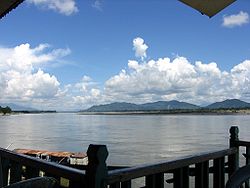 Irawaddy River below the dam site at Myitkyina
Irawaddy River below the dam site at Myitkyina
The dam site is located 3.2 km (2.0 mi) mile below the confluence of the Mali River and the N'Mai River about 42 kilometres (26.1 mi) north of Myitkyina, the capital of Kachin State, in northern Burma.[6]
The source of both the N'mai and Mali Rivers is the Himalaya glaciers of northern Burma in the vicinity of 28° N. The eastern most of the two, N'mai river, is the larger stream and rises in the Languela Glacier north of Putao. It is unnavigable because of the strong current whereas the smaller western river, the Mali, is navigable, despite a few rapids.[7]
History
The Myitsone Dam is part of the Confluence Region Hydropower Project (CRHP), which includes seven dams with a total installed capacity of 16,500 MW. CRHP alone accounts for 41 percent of the total power capacity called for by a 30-year strategic plan. Outlined in 2001, the plan includes 64 hydropower plants and three coal power plants with combined installed capacity of more than 40,000 MW.[8]
The Myanmar Electrical Power Enterprise and the Agriculture and Irrigation Ministry scheduled the Irawaddy Myitsone Dam Multipurpose Water Utilization Project in 2001. The survey phase was initiated in 2003. First the government contracted the Japanese Kansai Electric Power Company (KEPCO) to build a small weather station at Tang Hpre village, near the confluence. Chinese and Burmese contractors, including Yunnan Machinery Equipment Import & Export Company (YMEC), Kunming Hydropower Institute of Design, surveyed the dam site. In 2006, Suntac Technologies Co. Ltd., a Burmese Geographic Information System (GIS) mapping contractor set up an office at the monastery in Tang Hpre village. They also set up a temporary camp at Washawng village to facilitate transport of survey equipment from the YMEC company in China. In October, the Asia World Company built a project implementation camp on a hill top at the dam site 3 mi (4.8 km) downstream from the confluence. when the camp was complete, Chinese inspectors stayed and surveyed the area for five months. In December 2006, the Ministry of Electric Power No. 1 and the China Power Investment Corporation signed a Memorandum of Understanding for a 4,100 MW project at Myitsone and a 2,000 MW project at Chibwe.
The design phase began in 2007. The Changjiang Design Institute of China sent several groups of design personnel and conducted geological drilling, reservoir inspection and hydrological measuring near the dam site. To supply electricity for dam construction projects, a small 65 MW, Chibwe Creek hydroelectricity was built in April 2007. In May, the New Light of Myanmar reported that the Ministry of Power No. 1 and CPI would build seven hydropower dams on the N'Mai and Irawaddy rivers.
On 16 June 2009, Myanmar Ambassador Thein Lwin and President of China Power Investment Corporation Lu Qizhou signed a Memorandum of Agreement between the Department of Hydropower Implementation and the China Power Investment Corporation for the Development, Operation and Transfer of the hydropower Projects in Maykha, Malikha and Upstream of Irrawaddy-Myitsone River Basins.[9] The official opening ceremony of the dam construction phase was held on December 21.[10][11]
Economics
The majority of total US$3.6 billion cost was to be covered by the China Power Investment Corporation in a joint venture with the Asia World Company, Suntac Technologies, the Myanmar Electrical Power Enterprise, and Kansai Electric Power Company.[12] The Burmese government would get ten percent of the electricity generated and fifteen percent of the project shares. In addition, the government would charge a withholding tax and an export tax on exported electricity to China.[13] After a fifty-year period, the government would totally own the project free of charge.[14] Myanmar would receive US$17 billion from the project during the contracted fifty-year period.[15]
For all the seven dams in the Irrawaddy basin, the Burmese government was to get USD54 billion via taxation, free electricity and share dividends, far more than CPI's return on investment during the Chinese operation period according to the President of CPI.[14]
Design
The dam was planned to be a concrete faced rock-fill dam 152 m (498.7 ft) in both height and width, and projected to produce 3,600 megawatts (MW) of electricity by 2017.[2] This is equivalent to 16% of the 22,500 MW output of the Three Gorges Dam In China, the world's largest electricity-generating plant of any kind.[16]
Minister of Electric Power Zaw Min claimed that the dam was designed to withstand an earthquake of 8.0 Richter Scale, a scale that has never been recorded to have occurred in that region, and the most devastating flood of a millennium.[17]
Power generation
The Myitsone dam is the biggest of seven large dams currently planned on the Mali River, the N'Mai River and the Irawaddy rivers. The China Power Investment Corporation is project manager of the Confluence Region Hydropower Projects.[18] The seven dams combined total design installed capacity is 16,500 MW of electricity.[19]
The dam was to provide electricity primarily to the China Southern Power Grid via its subsidiary, the Yunnan Power Grid Company, in Yunnan Province and then on to the power hungry eastern coastal areas of China, in conformity with the Chinese central Government's 'West to East Transmission Policy'.[2][20] The hydropower project was being implemented under an agreement signed in late 2006 with the state-owned China Power Investment Corporation (CPI) and Burma’s Ministry of Electric Power No 1. The dam and reservoir planning and construction is managed by the Burmese government in cooperation with the China Southern Power Grid and several subcontractors.[21]
Social impact
The dam was expected to flood 766 km2 (295.8 sq mi) including 47 villages near the construction site and displace more than 10,000 ethnic Kachin people living in those villages.[22] The large military security presence, forced relocations, deforestation and floods would follow hand-in-hand with its construction according to The Irrawaddy news agency. The activists in exile stated that the dam would also submerge historical temples, churches and cultural heritage sites important to Kachin identity and history and the natural heritage of the Kachin people in Myitsone area would be lost.[21]
In response, the government reported in the state run New Light of Myanmar that relocated villages from the project area had been provided with all forms of aids including water, electric power and buildings and that the government also helped in relocation of religious buildings.[23] CPI reported a total expense of 4.1 billion kyats in compensation and 25 million US dollars in resettlement.[24] In addition, the government stated that the remote region would benefit greatly from the new roads and access to electricity.[23]
Local communities pointed out that the environmental impact, community displacement, and threat to cultural sites. Others opposed the dam site because it is less than 100 km (62.1 mi) from the major Sagaing fault line, posing a risk to basin inhabitants if an earthquake weakened the dam or caused landslides in the reservoir. If the Irrawaddy Myitsone Dam broke during an earthquake, it would endanger the lives of hundred of thousands of people downstream in Kachin State’s largest city, Myikyina.[25]
In response, the government said that the dam would withstand an earthquake of magnitude 8.0 Richter scale. On the other hand, Burmese scientists, who carried out the environmental assessment, recommended to build two smaller dams farther upstream instead of building on earthquake-prone zone.[26] In an interview with Xinhua News, Lu Qizhou, President of China Power Investment Corporation,said Myitsone Hydropower Station follows the standard of fortification intensity 9, two points above the intensity of Zipingbu Hydropower Station that withstood 2008 Sichuan earthquake of 8.0 Richter scale. [14]
Environmental impact
As with other large dam projects, the Myitsone Dam construction would have altered the hydrological characteristics of the river and prevent sediment from enriching the traditionally highly productive agricultural floodplains downstream.[27] This can affect fertility as far downstream as the Irrawaddy Delta, the major rice-producing area of Myanmar. The government responded that officials had taken sediment accumulation into consideration, and that the Myintsone dam would have capabilities to discharge the accumulated sediment.
Other consequences of flooding by the reservoir include loss of farmland and loss of spawning habitat as fish cannot swim upstream anymore. This would lead to lost income for fishermen according to Kachin environmental activist groups in exile.[28] On the other hand, research by Biodiversity And Nature Conservation Association (BANCA) contradicts the activists' statement. BANCA's research asserts that commercial fishing is not reported from the project area. But, it confirms that some resident aquatic species will be affected by the change in hydrological conditions.[29]
Ecological concerns focus on the inundation of an area that is the border of the Indo-Burma and South Central China biodiversity hotspot. The Mali and N'mai River confluence region falls within the Mizoram-Manipur-Kachin rainforests. Nevertheless, the dam would increase the shipping capacity of Irrawaddy river. The number of floods occurring once per year would be reduced to once every twenty years. Since the hydropower is the renewable energy, the energy produced by the dam would decrease the need for air polluting sources of energy such as fossil fuel. The construction and the maintenance of the dam would have employed a large number of people.
Opposition
Local villages have opposed the project since its proposal in 2001. In 2007, 12 local leaders from Kachin State sent a letter to Senior General Than Shwe and the junta’s Ministry of Electric Power asking for the project to be cancelled.[6] Burma Rivers Network also sent a letter to the Chinese government asking Chinese companies operating in Burma to conduct environmental and social impact assessments, publicly release information, and to include affected communities in the decision-making process.[21] In a parliamentary session, government minister Zaw Min responded that environmental impact had been carried out by the Biodiversity And Nature Conservation Association (BANCA) at a cost of USD1.25 million and stated that Myitsone Dam Project was started only when the government had studied the possible impacts environmentally.[30] However, the results of BANCA's assessment were not disclosed publicly.[31]
Outside Burma, activists in exile have actively carried out protests in various countries. In February 2010, the UK-based Kachin National Organization (KNO) protested against construction of the dam in front of the Burmese Embassies in the UK, Japan, Australia and USA.[10] Leaked United States diplomatic cables by Wikileak revealed that U.S embassy in Yangon funded some of the activist groups.[32]
Skirmishes have been broken out between Kachin Independence Army and Burmese military over the dam issue since June 2011.[33] On April 17, 2010, three bombs exploded close to the site of dam, killing four Chinese workers.[34] The Burmese government blamed Kachin Independence Army for planting the bombs. KIA has denied having anything to do with the Myitsone bombing.
Domestic campaigns against the project are brought together by political activists including Nobel peace prize laureate Aung San Suu Kyi, conservationists, scholars, poets and journalists.[12] Local media openly criticized the lack of transparency in dam project. Journalists argued that the deal was agreed by previous government without considering public opinions.[35] Burmese poets wrote several poems portraying the future of Irrawaddy river including The Dead River by Maung Sein Min.[36]
Despite the opposition, Minister Zaw Min for the Ministry of Electric Power responded to the press that the government would continue this project up to the completion.[37] But, in September 2011 he conceded that despite promised benefits from the project, it may be appropriate to minimize the environmental impacts by redesigning the tunnel, shortening the dam's height and reducing the water storage capacity, relocating to the upstream, and reassessing environmental impacts. He also agreed that final decision should depend on the environment impact assessment report by the Ministry of Environmental Conservation and Forestry and the study by the Engineer Group.[38]
Suspension
On 30 September 2011, in an address to the parliament, Burma's president Thein Sein announced that the Myitsone dam project would be halted during the term of his government.[3] The letter from the president consisted of ten points including,
As our government is elected by the people, it is to respect the people’s will. We have the responsibility to address public concerns in all seriousness. So construction of Myitsone Dam will be suspended in the time of our government. Other hydropower projects that pose no threat will be implemented through thorough survey for availability of electricity needed for the nation. I would like to inform the Hluttaws that coordination will be made with the neighbouring friendly nation, the People’s Republic of China, to accept the agreements regarding the project without undermining cordial relations.—Thein Sein, Letter to the parliament[39]The decision was universally acclaimed by environmentalists, political activists and locals alike.[39] It is considered as "a rare reversal" in that for the first time, the government had listened to the people in face of public opposition.[12][40]. Western nations including EU and the United States welcome the President's decision.[41][42]
In response, Chinese Foreign Ministry spokesman Hong Lei stated that the Chinese government has urged the Burmese government to protect the legal and legitimate rights and interests of Chinese companies.[43] He reminded that the Myitsone dam is a jointly invested project between China and Myanmar, and one that has been thoroughly examined by both sides.[44] He also confirmed that the matters would be resolved through friendly consultation.[4] The president of CPI, Lu Qizhou, has warned that a halt in construction could lead to legal action.[14]
In October 2011, Myanmar Foreign Minister traveled to Beijing to settle the dispute.
Analysis
Although the President Thein Sein's decision has been widely applauded, experts caution that Sino-Burma relation could be ultimately harmed by the suspension. Dr Nicholas Farrelly, a Southeast Asia specialist at the Australian National University in Canberra said that while there would inevitably be some short-term damage to bilateral relations pragmatism would override any potential for long-term animosity.[5] The issue is further exacerbated by the massacre of 13 Chinese sailors near Burma-Thailand border. [45]
Internationally, the suspension is considered as one of the democratic reforms along with other engagements such as dialogues with pro-democracy leader Aung San Suu Kyi and release of some political prisoners.[46] Marie Lall, a BBC South Asia analyst attributes Burma's bid for the Asean chair in 2014, the needs to reform the economy for ASEAN Free Trade Area and the government's desire to win the election in 2015 as the main motives of the reforms.[47]
Notes
- ^ BRN (2010). "Irrawaddy/N'Mai/Mali Dams". Burma Rivers Network.. http://www.burmariversnetwork.org/dam-projects/irrawaddynmaimali.html#5. Retrieved 4 February 2010.
- ^ a b c d Libre, Ryan (February 1, 2010). "Proposed dam to flood Burma, while powering China". MinnPost.com. http://www.minnpost.com/globalpost/2010/02/01/15488/proposed_dam_to_flood_burma_while_powering_china. Retrieved 15 February 2010.
- ^ a b c "Burma dam: Work halted on divisive Myitsone project". BBC. 30 September 2011. http://www.bbc.co.uk/news/world-asia-pacific-15121801. Retrieved August 30, 2011.
- ^ a b "A reporter asked Foreign Ministry spokesman Hong Lei". Government of China. http://www.mfa.gov.cn/chn/gxh/tyb/fyrbt/t864634.htm. Retrieved September 01, 2011.
- ^ a b San Oo. "China, Myanmar close in on agreement to settle dispute over Myitsone suspension". MM Times. http://www.mmtimes.com/2011/news/597/news59707.html. Retrieved November 13, 2011.
- ^ a b "Irrawaddy Myitsone Dam". Burma. International Rivers. http://www.internationalrivers.org/en/southeast-asia/burma/myitsone-dam. Retrieved 4 February 2010.
- ^ James R Penn (2001) Rivers of the World. Santa Barbara, Calif. [u.a.] ABC-Clio ISBN 1-57607-042-5 9781576070420. Page 115 paragraph 2, retrieved d.d. July 16, 2009/
- ^ "President halts dam". MM times. http://www.mmtimes.com/2011/news/595/news59501.html. Retrieved October 08, 2011.
- ^ "Memorandum of Agreement on N’Mai/Mali/Irrawaddy Dams Signed". Excerpts from New Light of Myanmar. Burma Rivers Network. 2009-06-21. http://www.burmariversnetwork.org/news/news-archives/202-memorandum-of-agreement-on-nmaimaliirrawaddy-dams-signed.html. Retrieved 16 February 2010.
- ^ a b Kachin News Group (2010-01-27). "Exiled Kachins urge China to stop Irrawaddy Myitsone dam project". Burma News International. http://www.bnionline.net/news/kng/7775-exiled-kachins-urge-china-to-stop-irrawaddy-myitsone-dam-project-.html. Retrieved 3 February 2010.
- ^ "Resisting the Flood". Kachin Development Networking Group. 10-2009. pp. 12, 13. http://www.scribd.com/doc/22702866/Resisting-theFlood. Retrieved 5 February 2010.
- ^ a b c Rachel Harvey (August 31, 2011). "Burma dam: Why Myitsone plan is being halted". BBC. http://www.bbc.co.uk/news/world-asia-pacific-15123833. Retrieved August 31, 2011.
- ^ Ei Ei Toe Lwin and Aye Thidar Kyaw (September 19 - 25, 2011). "Despite protest, minister vows govt will continue dam project". MM times. http://www.mmtimes.com/2011/news/593/news59302.html. Retrieved August 31, 2011.
- ^ a b c d "Myitsone Hydropower Project mutually beneficial". Xinhua News. October 04, 2011. http://www.chinadaily.com.cn/china/2011-10/04/content_13836037.htm. Retrieved October 04, 2011.
- ^ "Speech of Eleven Media Group Chairman & CEO Dr. Than Htut Aung on Myitsone Hydropower Project". Eleven News. http://eversion.news-eleven.com/index.php?option=com_content&view=article&id=1481:dr-than-htut-aung&catid=42:weekly-eleven-eversion&Itemid=109. Retrieved August 31, 2011.
- ^ "top-100-pt-4". Industcards.com. http://www.industcards.com/top-100-pt-4.htm. Retrieved 2009-08-01.
- ^ "Myitsone Hydropower Project to be reviewed: Report". Eleven. http://eversion.news-eleven.com/index.php?option=com_content&view=article&id=1466:myitsone-hydropower-project-to-be-reviewed-report&catid=42:weekly-eleven-eversion&Itemid=109. Retrieved October 01, 2011.
- ^ SupervisoryOffice of Confluence Region Hydropower Project Opened on the Myanmar Information Website May 7, 2007. Paragraph 4. Retrieved d.d. September 17, 2009
- ^ "Environmental impact assessment" (Press release). BANCA. October 2009. http://www.burmariversnetwork.org/images/stories/publications/english/EIA_Report.pdf. Retrieved August 31, 2011.
- ^ Staff, KEO, Execuative Summary
- ^ a b c Naing, Saw Yan (2010-02-15). "Irrawaddy Dam Construction Begins, Human Rights Abuses Begin". The Irrawaddy / News. Irrawaddy Publishing Group. http://www.irrawaddy.org/article.php?art_id=10064. Retrieved 15 February 2010.
- ^ "CSG’s Initial Public Offering and Project Risks in Southeast Asia". International Rivers. May 13, 2008. http://www.internationalrivers.org/files/China%20Southern%20Grid%20Letter%20-%20English.pdf. Retrieved February 15, 2010.
- ^ a b "In future, large hydropower projects must be implemented successfully with domestic industrial products, national experts and national skilled workers only". New Light of Myanmar. 22 January, 2001. http://www.myanmar.com/newspaper/nlm/Jan25_01.html. Retrieved August 31, 2011.
- ^ "Resettlement work". China Power Investment. http://www.uachc.com/Liems/esite/content/showDetail.jsp?nid=6859&newtype_no=2248. Retrieved October 03, 2011.
- ^ Rachel Harvey (August 31, 2011). "Burma dam: Why Myitsone plan is being halted". BBC. http://www.bbc.co.uk/news/mobile/world-asia-pacific-15123833. Retrieved August 31, 2011.
- ^ "Controversy Over Dam Fuels Rare Public Outcry in Myanmar". New York Times. September 21, 2011. http://www.nytimes.com/2011/09/22/world/asia/controversy-over-dam-fuels-rare-public-outcry-in-myanmar.html?pagewanted=all. Retrieved August 31, 2011.
- ^ William L. Graf (1999) Dam nation: A geographic census of American dams and their large-scale hydrologic impacts page 5, published Water Resources Research, Vol. 35, No. 4, pages 1305-1311, April 1999
- ^ Staff, KEO, p 23
- ^ EIA report, pp 27
- ^ "Myitsone Hydropower Project will not be discarded anyhow despite objections from any sources: Electric Power Minister". Eleven Media Group. http://eversion.news-eleven.com/index.php?option=com_content&view=article&id=1449:myitsone-dam-project-will-not-be-discarded-anyhow-despite-objections-from-any-sources-electric-power-minister&catid=42:weekly-eleven-eversion&Itemid=109. Retrieved August 31, 2011.
- ^ Hein Min Latt. "BANCA Chairman advocates transparency on EIA report". Eleven Media Group. http://eversion.news-eleven.com/index.php?option=com_content&view=article&id=1449:myitsone-dam-project-will-not-be-discarded-anyhow-despite-objections-from-any-sources-electric-power-minister&catid=42:weekly-eleven-eversion&Itemid=109. Retrieved August 31, 2011.
- ^ Wikileak. "US embassy cables: how Rangoon office helped opponents of Myitsone dam". United States government. Gurdians. http://www.guardian.co.uk/world/2011/sep/30/us-embassy-cables-burma-myitsone-dam. Retrieved October 02, 2011.
- ^ "Myanmar govt shelves $3.6 bln mega dam - officials". Reuters. http://in.reuters.com/article/2011/09/30/idINIndia-59646920110930. Retrieved October 02, 2011.
- ^ http://www.dvb.no/news/kachin-dam-bombing-kills-four/8640
- ^ "Myanmar govt shelves $3.6 bln mega dam - officials". Reuters. http://in.reuters.com/article/2011/09/30/idINIndia-59646920110930. Retrieved October 02, 2011.
- ^ "Controversy Over Dam Fuels Rare Public Outcry in Myanmar". New York TImes. http://www.nytimes.com/2011/09/22/world/asia/controversy-over-dam-fuels-rare-public-outcry-in-myanmar.html. Retrieved October 02, 2011.
- ^ "Myitsone Hydropower Project will not be discarded anyhow despite objections from any sources: Electric Power Minister". Aung Khin. Eleven Media Group. 11 September 2011. http://eversion.news-eleven.com/index.php?option=com_content&view=article&id=1449:myitsone-dam-project-will-not-be-discarded-anyhow-despite-objections-from-any-sources-electric-power-minister&catid=42:weekly-eleven-eversion&Itemid=109. Retrieved September 25, 2011.
- ^ "Myitsone Hydropower Project to be reviewed: Report". Eleven. http://eversion.news-eleven.com/index.php?option=com_content&view=article&id=1466:myitsone-hydropower-project-to-be-reviewed-report&catid=42:weekly-eleven-eversion&Itemid=109. Retrieved October 01, 2011.
- ^ a b "President Thein Sein sent a letter to parliament for cancellation of Myitsone dam project". Eleven Media Group. August 31, 2011. http://www.news-eleven.com/index.php?option=com_content&view=article&id=10335:2011-09-30-04-38-33&catid=42:2009-11-10-07-36-59&Itemid=112. Retrieved August 31, 2011.
- ^ HANNAH BEECH (August 31, 2011). "In a Rare Reversal, Burma's Government Listens to Its People and Suspends a Dam Read more: http://globalspin.blogs.time.com/2011/09/30/in-a-rare-reversal-burmas-government-listens-to-its-people-and-suspends-a-dam". Time Online. http://globalspin.blogs.time.com/2011/09/30/in-a-rare-reversal-burmas-government-listens-to-its-people-and-suspends-a-dam/. Retrieved August 31, 2011.
- ^ "EU Welcomes Burmese Decision on Myitsone Dam". VOA. October 03, 2011. http://blogs.voanews.com/breaking-news/2011/10/03/eu-welcomes-burmese-decision-on-myitsone-dam/. Retrieved October 03, 2011.
- ^ "US welcomes Myanmar decision to halt dam". Taiwan News. October 03, 2011. http://www.taiwannews.com.tw/etn/news_content.php?id=1722578. Retrieved October 03, 2011.
- ^ "China wants talks after Myanmar halts dam project". AP. http://www.google.com/hostednews/ap/article/ALeqM5iOZ3WITtW9CP0wdt0nLUHyHK1N0A?docId=caea755eb6f8488bb6e842edbd4df2f1. Retrieved October 01, 2011.
- ^ Ben Blanchard (Oct 1, 2011 7:19am EDT). "China calls for talks over shelved Myanmar dam". Reuters. http://www.reuters.com/article/2011/10/01/us-china-myanmar-dam-idUSTRE7900N120111001. Retrieved October 01, 2011.
- ^ "Myanmar reassures China after dam blocked, sailors killed". Reuters. http://www.reuters.com/article/2011/10/30/us-china-myanmar-idUSTRE79T0K420111030. Retrieved November 13, 2011.
- ^ Thaung Tun. "Major steps in Myanmar's transformation". Today. http://www.todayonline.com/Commentary/EDC111018-0000150/Major-steps-in-Myanmars-transformation. Retrieved November 13, 2011.
- ^ Marie Lall (7 November 2011). "Viewpoint: Has a year of civilian rule changed Burma?". BBC. http://www.bbc.co.uk/news/world-asia-15560414. Retrieved November 13, 2011.
References
- Staff, KEO,Damming the Irrawaddy (2008) Chiang Mai, Kachin Environment Organization, Kachin Development Networking Group. Burmese copy, Chinese copy
Categories:- Dams in Burma
- Dam controversies
- Proposed hydroelectric power stations
- Hydroelectric power stations in Burma
- Kachin State
- Dams under construction
- Concrete-face rock-fill dams
Wikimedia Foundation. 2010.

